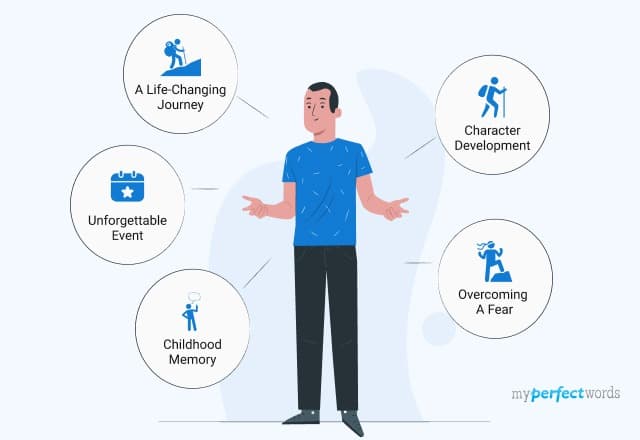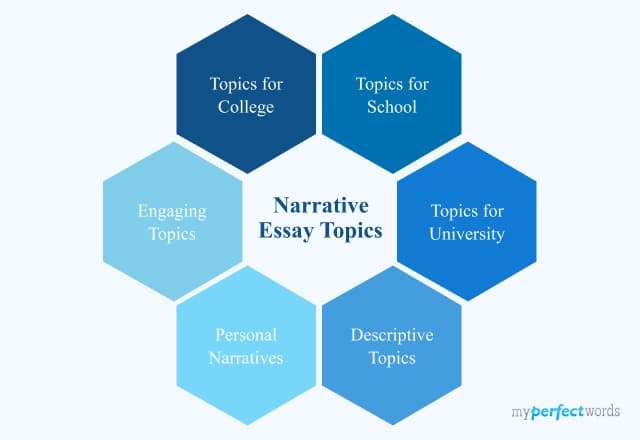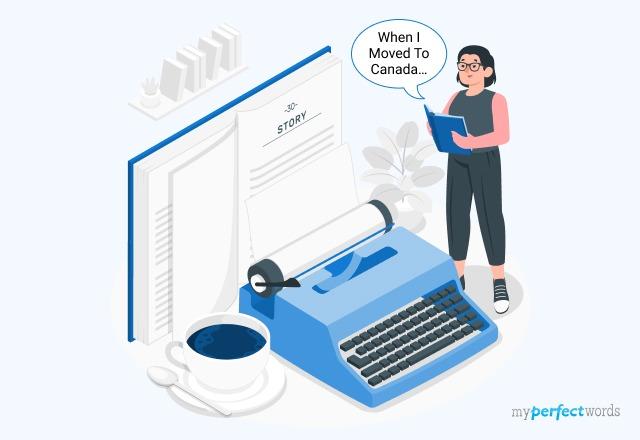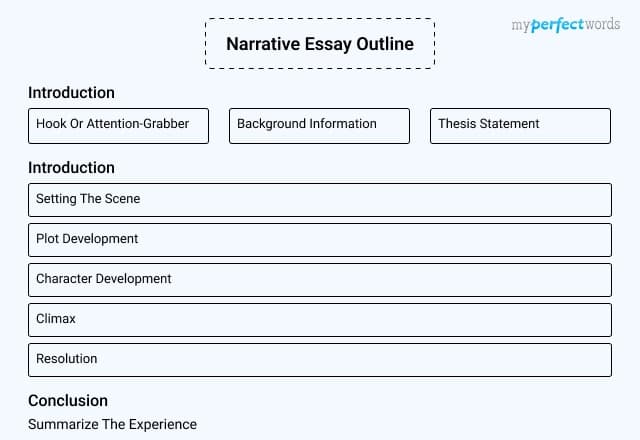
Writing a personal narrative essay can be a difficult task, but it's also an incredibly rewarding form of self-expression and a valuable tool in education.
Whether you're a high school student preparing for college applications or a college student, focused on improving your narrative writing skills, this blog has everything you need.
This blog will guide you through the process, providing expert tips and examples to help you succeed.
So let’s get right into it!
On This Page![]()
- 1. Understanding Personal Narrative Essays
- 2. 6 Steps on How to Write a Personal Narrative Essay
- 3. Personal Narrative Essay Examples
- 4. Expert Tips for Writing Personal Narrative Essays
- 5. Common Mistakes to Avoid When Writing Personal Narrative Essays
Understanding Personal Narrative Essays
A narrative essay may include the option to create fictional narratives or stories. However, a personal narrative essay involves sharing personal experiences or recounting stories from a first-person perspective.
Personal narratives allow the writer to reflect on their experiences and share insights, while also connecting with the reader on a personal level.
This genre encourages self-expression and enhances one's storytelling and communication skills.
6 Steps on How to Write a Personal Narrative Essay
Writing a personal narrative essay involves several key factors. Let's delve into the essential steps of crafting a compelling personal narrative essay:
Step 1: Choosing the Right Topic
Selecting the perfect essay topic is a critical first step in the writing process. It will help you focus on the specific topic and maintain the flow;
Here are some strategies to help you decide:
- Reflect on Personal Experiences: Start by considering your life experiences, especially those that have deeply impacted your thoughts, feelings, or personal growth.
- Identify a Lesson Learned: Go for a topic that involves a valuable lesson or transformative moment. This could be an insightful realization or an experience that left a lasting impression.
- Resonate with Your Reader: Ensure that your chosen topic not only resonates with you but can also connect with your audience.
Here is a list of personal narrative essay topics you can choose from to get an idea:
- A Life-Changing Journey: Reflect on a travel experience that transformed your perspective.
- Overcoming a Fear: Share the story of how you conquered a significant fear or phobia.
- The Day Everything Changed: Describe a pivotal day in your life that had a profound impact.
- Lessons from Failure: Discuss a time when you faced failure and the valuable lessons you learned.
- An Unforgettable Family Event: Write about a memorable family gathering or celebration.
- A Milestone Achievement: Reflect on a significant achievement in your life and the journey to reach it.
- A Childhood Memory: Revisit a cherished childhood memory that continues to influence you.
- Navigating a Personal Challenge: Share the story of how you tackled a personal obstacle or adversity.
- An Unexpected Act of Kindness: Write about a time when someone's kindness made a lasting impression on you.
- A Cultural Experience: Discuss an encounter with a different culture that expanded your understanding of the world.
Take a look at this list of narrative essay topics to get inspiration for your essay.
Step 2: Creating a Compelling Introduction
The introduction of your personal narrative essay is the reader's first encounter with your story.
Here is what you should keep in mind while creating the introduction:
- Engage the Readers: An introduction can help engage your readers with a hook. Your opening should spark their interest and make them eager to read on.
- Starting Effectively: Provide an engaging anecdote, posing a thought-provoking question, or presenting a compelling fact related to your story.
- Thesis Statement: This brief yet impactful sentence guides your narrative, giving readers a sneak peek into your story's main point.
Let’s take a look at the example below to help you have a better understanding:
When I received the acceptance letter from my dream university, I thought my life was finally falling into place. Little did I know that it was the beginning of a tumultuous journey filled with unexpected challenges and invaluable life lessons. This is the story of how a small-town girl ventured into the big city, the year I spent discovering myself, facing adversity, and ultimately emerging stronger than ever. Join me on this narrative as I share the rollercoaster ride that was my freshman year in college, a time when the world outside of my comfort zone became my greatest teacher. |
The introduction effectively captures the reader's attention. It introduces the central theme and purpose of the narrative. It also sets the stage for the forthcoming story.
Step 3: Developing the Plot
The development of your narrative's plot is an important part of your personal narrative essay.
Follow these guidelines:
- Structured Narrative: A clear sequence of events is crucial to make your story relatable and understandable. It ensures that your narrative flows smoothly.
- Readable Storyline: A well-developed plot has an easy-to-follow storyline. This enhances the credibility and relatability of your narrative, making it more engaging.
Let’s take a look at the example of the body paragraph to help you have a better understanding:
I arrived at the train station just as the sun was beginning to set, casting a warm, golden glow over the platform. The anticipation had been building for weeks, and now, the moment had finally come. I was about to embark on a cross-country journey, leaving behind the familiar and embracing the unknown. As I stepped onto the train, the doors closed behind me with a reassuring 'click,' and I found my seat by the window. The rhythmic clatter of the wheels on the tracks soon lulled me into a sense of serenity. I watched the landscape change, from the urban sprawl of the city to the quiet countryside, and a feeling of freedom washed over me. With every passing mile, I could sense the adventure unfolding, and I knew that this journey would be the catalyst for a profound change in my life. |
This paragraph smoothly transitions from the anticipation of a journey to the moment of boarding the train and then to the changing landscape, creating a smoother flow of events.
Step 4: Character Development
Enhancing your storytelling through character development is crucial for a captivating personal narrative essay.
This element adds depth and relatability to your story, making it more engaging for readers.
Here's how you can achieve it:
- Characterizing the Writer and Others: Portray yourself and other individuals in your narrative with authenticity and complexity. This makes the characters relatable and captivating.
- Influence on the Essay's Impact: Understand that character development shapes how readers perceive and understand your experiences. This can profoundly impact the essay's overall effect.
Let’s look at this example to understand how character development can be achieved:
As I embarked on my first solo backpacking adventure through the remote mountains, I found myself in the company of an unexpected companion. His name was John, a seasoned hiker I met at a trailhead. John had an unruly beard, sun-weathered skin, and a twinkle in his eye that hinted at a lifetime of adventures. We started our journey as strangers, but throughout the trek, our dynamic evolved into something extraordinary. At the beginning of our trip, I was timid and unsure of myself, while John exuded confidence and an air of self-sufficiency. He effortlessly navigated the rugged terrain, deftly setting up camp, starting fires, and finding edible plants. I was in awe of his abilities, but I kept my distance, feeling like an inexperienced interloper in his world. However, as the days turned into weeks, the character of our relationship began to change. John, in his wisdom, recognized my desire to learn and grow. He became a patient mentor, taking the time to teach me essential survival skills, from identifying safe water sources to reading the signs of impending weather changes. In the crucible of our journey, I underwent a remarkable transformation. I evolved from a timid novice to a more confident and self-reliant traveler. John's character, initially portrayed as a rugged individualist, became that of a compassionate mentor who understood the value of nurturing growth in others. This shift in our characters profoundly influenced the essay's impact. The narrative not only tells the story of a challenging mountain trek but also reveals a personal journey of growth and transformation. Character development is at the heart of this narrative, showcasing how the evolving relationship between two individuals can shape the reader's perception and understanding of the experiences described. It's a testament to the profound impact that character development can have on a personal narrative essay. |
This example effectively illustrates how character development can be a powerful tool in a personal narrative essay. It transforms a simple adventure story into a deeper exploration of personal growth and the dynamics between individuals.
Step 5: Using Descriptive Language
To make your personal narrative more immersive, focus on these techniques:
- Vivid and Descriptive Language: Use vivid and descriptive words and phrases to create mental images and evoke emotions, allowing readers to step into your narrative.
- Sensory Details: Engage readers' senses - sight, sound, touch, taste, and smell - to bring your story to life.
This example portrays these techniques effectively:
The sun dipped below the horizon, casting the sky in hues of burnt orange and deep crimson. The air held a crispness that signaled the arrival of autumn, and as I stepped into the forest, the earth beneath my boots crunched with the fallen leaves. The scent of pine and damp earth enveloped me, a comforting reminder of the countless hikes I had undertaken in this place. As I ventured deeper into the woods, a gentle breeze rustled the leaves above, creating a soothing, almost melodic backdrop to my journey. The play of dappled sunlight and shadow on the forest floor gave life to the dance of leaves carried by the wind. I couldn't help but reach out and run my fingers along the rough bark of a tree, feeling its ancient presence and the stories it held. |
This descriptive language creates a vivid and immersive experience for the reader. By engaging the senses, readers can step into the author's experience, making the story more engaging and memorable.
Step 6: Crafting a Memorable Conclusion
Your conclusion leaves a lasting impression. Consider these key aspects:
- Purpose of a Strong Conclusion: A strong conclusion ties up loose ends, provides insight, or conveys a meaningful message, resonating with readers.
- Leaving a Lasting Impression: Reflect on lessons learned, offer a thought-provoking statement, or leave readers with a powerful image or emotional impact.
Here is an example to help you have a better understanding:
As I gazed at the receding shoreline from the sailboat's bow, a sense of contentment washed over me. The vast expanse of the sea had become a metaphor for life's uncertainties, and the journey I had embarked upon mirrored the unpredictability of our own paths. In this fleeting moment, I grasped a profound lesson: The real voyage was not about the destination but the transformation that occurred along the way. As the sun dipped below the horizon, I understood that life's most beautiful moments were often found in uncharted waters. With a heart full of gratitude and the wind in my hair, I knew that this voyage had marked not just a physical journey but a deeper, soulful one. It was a reminder that embracing the unknown could lead to the most meaningful discoveries. |
This conclusion provides insight by emphasizing the transformative nature of the journey. It resonates with the reader through a reflection on life's unpredictabilities and the beauty of embracing the unknown.
Personal Narrative Essay Examples
Examples are incredibly helpful in understanding the art of personal narrative essay writing.
Let's take a look at the personal narrative essay examples for inspiration and to help you understand the points made previously:
Topic: Running Towards Triumph: My First 10k Race The summer sun beat down on the hot asphalt, radiating waves of heat. I stood at the starting line of the 10k race, surrounded by a sea of determined faces. My heart pounded like a drum, and my legs felt like jelly. It was my first-ever competitive race, and I was filled with a mixture of excitement and anxiety. As the starting gun fired, I was engulfed in a whirlwind of motion. Runners surged ahead, and I fell into step with the rhythm of the race. The pounding of sneakers on the pavement and the sound of heavy breathing filled the air. The salty sweat on my skin mixed with the sunblock, creating a unique scent that could only be found at a summer race. The first few kilometers were a blur. I focused on my breathing and the rhythm of my steps, trying to find a pace that I could sustain. The sun bore down mercilessly, and I could feel the beads of sweat trickling down my back. As I approached the halfway point, doubt crept into my mind. My legs were heavy, and my lungs felt like they were on fire. But just as the thought of giving up began to take hold, I spotted a familiar face in the cheering crowd. It was my best friend, Sarah, holding a colorful sign that read, "You've Got This!" Seeing Sarah's unwavering support rekindled my determination. I pushed through the pain, drawing on a reserve of strength I didn't know I had. The rhythm of the race changed, and my focus shifted from self-doubt to the goal of crossing the finish line. The last kilometer was a test of willpower. My body ached, and my breath came in ragged gasps. But I refused to give in. The crowd's cheering grew louder, and I could see the finish line in the distance. With every ounce of strength, I sprinted towards it, the cheers of the spectators fueling my final push. Crossing the finish line was a moment of triumph. The sense of accomplishment and the rush of endorphins flooded my body. I had completed my first race, and it was an experience filled with vivid sensations, from the pounding of my heart to the cheers of the crowd. In retrospect, that race was more than just a physical challenge; it was a journey of self-discovery. The doubts and the triumphs, the scent of sweat and sunscreen, and the unwavering support of a friend all came together to create a narrative of growth and determination. |
Here are some more examples you should consider:
Take a look at some more narrative essay examples to have a better understanding of structuring your essays.
Expert Tips for Writing Personal Narrative Essays
Here are some expert tips for writing personal narrative essays:
- Choose a Unique Perspective: Find a unique angle or perspective for your personal narrative essay. Whether it's a specific moment, a lesson learned, or a personal growth experience, a unique perspective can make your essay stand out.
- Stay True to Your Voice: While it's essential to follow the rules of writing, don't lose your unique voice. Personal narrative essays are about self-expression, so let your personality shine through in your writing.
- Reflect and Analyze: Don't just recount events; reflect on their significance and analyze how they shaped you. Mention what you learned from the experience and the insights you gained.
- Show, Don't Tell: Instead of simply telling your readers about your experiences, show them through vivid descriptions and sensory details.
- Use Dialogue Sparingly: Incorporate dialogue to make your story more dynamic and realistic. However, use it judiciously, focusing on the most crucial conversations that drive the plot or reveal character traits.
- Consider Your Audience: Keep your audience in mind while writing. Tailor your language and style to the intended readers to ensure your narrative resonates with them.
- Seek Feedback: Share your essay with peers, teachers, or mentors for constructive feedback. An outside perspective can help you refine your narrative and identify areas for improvement.
Common Mistakes to Avoid When Writing Personal Narrative Essays
Here are common mistakes to avoid when writing personal narrative essays:
- Lack of Reflection: Failing to reflect on the significance of the events can make your narrative feel superficial. Don't just narrate; analyze and share insights or lessons learned.
- Neglecting Structure: A disorganized narrative can confuse readers. Ensure a clear structure with a beginning, middle, and end. Use transitions to guide the reader through the story.
- Ignoring the Editing Process: Rushing to publish your essay without thorough editing can lead to grammar and spelling mistakes, as well as unclear or confusing passages. Take time to revise and proofread your work.
- Overly Complicated Language: Avoid using overly complex language or jargon that may alienate readers. Clear and concise language is often more effective.
- Inconsistency in Verb Tenses: Stick to one verb tense throughout the essay. Shifting between past and present tense can disrupt the narrative's flow.
So there you have it!
By following this guide, you'll be well-equipped to write compelling personal narrative essays. You can craft compelling, meaningful stories that engage and resonate with your audience.
Are you in search of the best online essay writing service? We have got you covered.
Our narrative essay writing service has experienced writers skilled in crafting high-quality essays. Whether it's a narrative essay or any other type, we're here to provide top-notch results.
So, request 'write my essay' today and relieve your academic burden.

Write Essay Within 60 Seconds!
Use our AI tool to generate high quality essay
WRITTEN BY
Caleb S.
Caleb S. has been providing writing services for over five years and has a Masters degree from Oxford University. He is an expert in his craft and takes great pride in helping students achieve their academic goals. Caleb is a dedicated professional who always puts his clients first.




